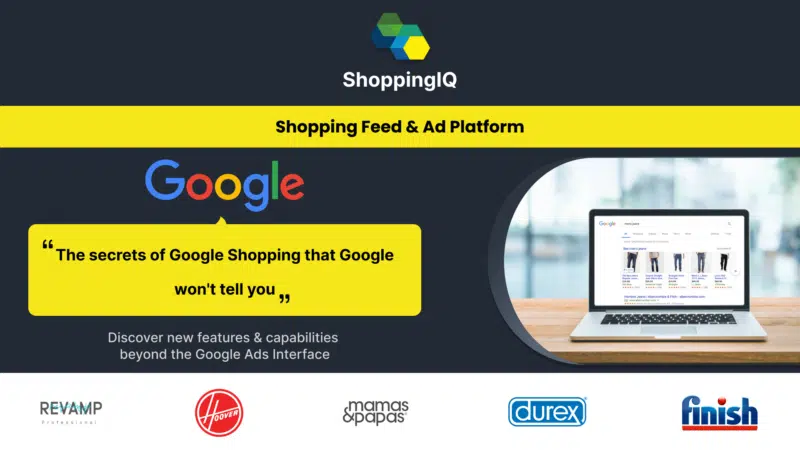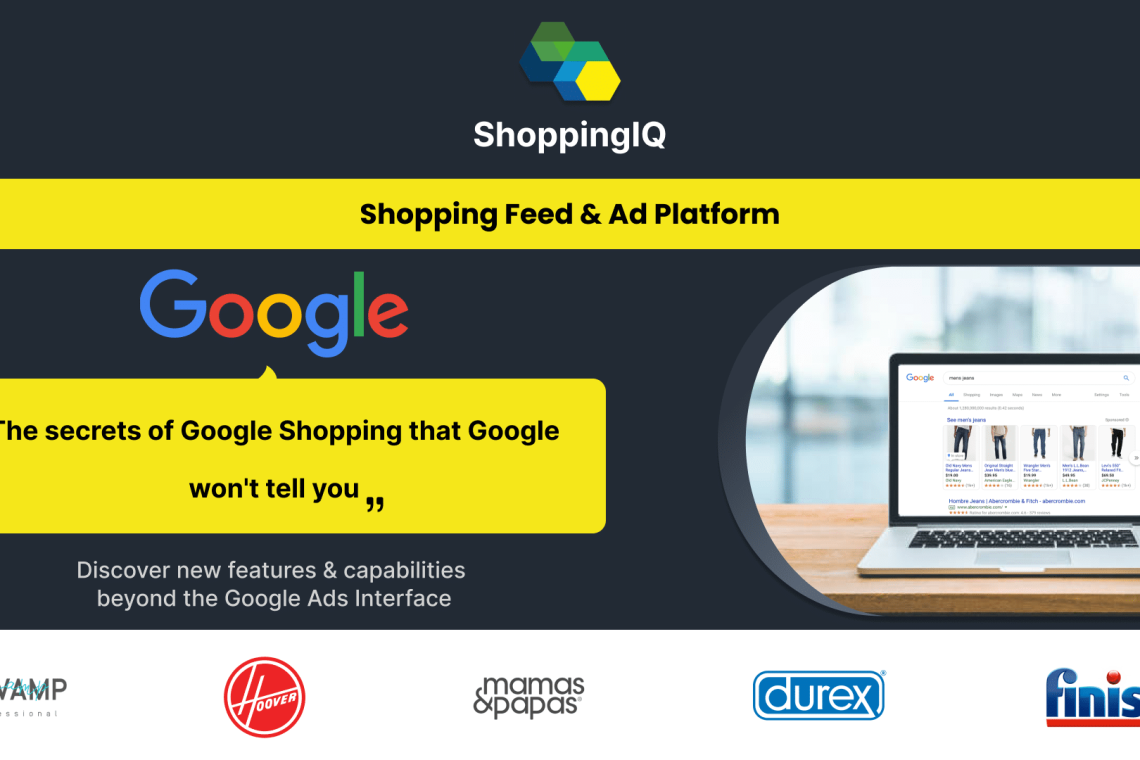5 essential Google Shopping optimizations Google won’t tell you
[ad_1]

Google Shopping Ads are a powerful platform for increasing your sales. With Black Friday fast approaching, implementing the latest tactics is crucial to ensure your ad spend is invested wisely amid rising costs per click.
These five essential optimizations that will instantly impact your campaigns are brought to you by Google Shopping Feed partner ShoppingIQ, who specializes in overcoming existing limitations of Google Shopping and Performance Max campaigns, whist developing extra features, optimizations and targeting options that are not accessible through the Google Ads or Google Mercant Center interface.
Within this guide, Alam Hosseinbor, ecommerce director at ShoppingIQ, unveils a number of “secrets that Google won’t tell you” and emphasizes that “shopping advertisers unknowingly waste thousands of dollars per year without realizing.”
Follow the link at the end of this blog post to download the full list of tips and access your free one-hour consultation for more bespoke advice and tactics. The below five optimizations are critical and we strongly suggest they are reviewerd and implemented ASAP.
1. Real-time feed stock updates
A shocking fact: for more than 95% of ecommerce brands, even after their products go out of stock, their product ads stay active on Google Shopping for 12 to 24 hours, and in some cases longer. This leads to unnecessary CPC charges, reduced ROI and frustrates customers when they arrive at pages with out-of-stock items. While this not only drains your budget, it also leads to product disapprovals due to incorrect stock status. Furthermore, as your best-selling items are most likely to go out of stock, this adversely affects the bidding algorithm as Google’s latest signals perceive these products as live but unproductive, pushing them down the priority list when they are back in stock.
Take a look at this video, which serves as an example of how Argos, a prominent U.K. retailer, was unintentionally wasting its advertising budget on products that were out of stock during its Black Friday campaign when CPC rates were already soaring due to heightened competition. In the video, you can witness an active ad directing a user to the relevant landing page, only to discover that the product they clicked on is no longer available. This negatively impacts the budget and provides a suboptimal customer experience from a branding and technological perspective.
So, what’s the solution to this problem? If you rely on Google Sheets, FTP or XML links to manage your feeds in Google Merchant Center, there’s a higher likelihood that you’re facing this issue, although it’s not exclusive to these file formats. ShoppingIQ has developed a unique, real-time proprietary stock updating technology, and leveraging this technology is essential. It prevents unnecessary ad spend on out-of-stock items, particularly during inflated CPC rates, safeguarding your budget and ensuring efficient expenditure throughout the year, especially during peak seasons when CPCs are at their highest.
2. Real-time feed price updates
Real-time stock updates are important, but the same goes for pricing. Delays in getting your price drops to market also slow down your revenue potential during sale periods. For instance, during a sale, you would want to capitalize on the increased click-through rates (CTR) and sales that price drops provide immediately, not on your next feed update, typically the next day. This issue becomes especially critical during limited-time events such as Black Friday or weekend sales. In the same video as above, where you saw Argos paying for an out-of-stock click, it follows with the same user experiencing another issue who was forced back to the results pages to choose an alternative shop. This time, Amazon is at fault for promoting an inaccurate price that misleads the customer. In this instance, as the actual website price is higher, it frustrates the customer and lowers the conversion rate due to the deceptive pricing information.
It is highly recommended to maximize performance and efficiency by having the ability to reflect and adjust your product prices in your live ads in real-time, harnessing market changes and tactical opportunities. This feature proves invaluable for businesses frequently running sales or promotions, as it guarantees that your ads reflect the most up-to-date pricing information. While this also reduces product disapproval, keeping your prices correct and maximizing the revenue from price drops as they happen is essential.
3. Incremental converting keyword insights and keyword targeting
In a landscape where Google and Performance Max campaigns are reducing insight and optimization control, ShoppingIQ puts control back in the hands of advertisers. It allows precise control over your products’ appearance in Google Shopping search results. You can target your ads using a range of keywords, including product names, brand names and product attributes. This precision ensures that your ads reach potential buyers with the highest intent.
Importantly, converting keyword insights at the product level are provided even for Performance Max campaigns, and such data is certainly not available via the Google Ads interface. This strategy includes providing brands with additional data to support product feed title, description optimization and incremental keyword targeting.
4. 20% CPC discount
A Google CSS partner like ShoppingIQ offers a permanent discount on your Google Shopping spend. This discount is applied to your account and gives your shopping campaigns 20% more bidding power without extra charges. As a result, your cost per click will end up being cheaper. For example, reducing your bids by 20% will be equivalent to the same bid you had before. Therefore, this discount will quickly reduce advertising costs and enhance your ROI. It’s a straightforward process with no need for alterations to your existing ad campaigns. Please note that this discount is only available for ad campaigns running activities in the U.K. or EU. This discount was mandated for Google by EU courts due to anti-competitive reasons and to acknowledge the contributions of Google feed partners in helping brands grow their online shopping spends on Google. We highly recommend that you opt for this discount, as Google is unlikely to inform you about it.
5. Free competitor tracking
ShoppingIQ goes a step further by providing free competitor tracking. This feature lets you compare your products with your competitors regarding price, availability and impression share in Google Shopping search results. This invaluable data enables you to identify areas for campaign improvement and stay ahead of the competition. Additionally, you can dynamically adjust your product offerings based on price competitiveness.
Beyond these five core advantages, there are a host of additional features to refine your Google Shopping campaigns:
• Advanced reporting and analytics: Gain deep insights into your campaign’s performance to refine your strategies.
• Automated bidding: Optimize your bidding strategies to maximize ROI.
• Image optimizations: Make your ads visually appealing to stand out.
• Product optimization tools: Fine-tune your product listings for better visibility.
• Advanced product optimizations: Implement advanced tactics to improve product rankings.
In summary, these tips are suitable for businesses of all sizes seeking to enhance their Google Shopping campaign performance.
For tips and advice for your brand, we recommend you take advantage of the free 1-hour consultation. You will learn more about the plenty of incremental features not available via the Google Ads interface, and to enhance your performance beyond the limitations of Google Performance Max campaigns.
For more comprehensive guidance and additional tips to grow your revenue efficiently and quickly, you can download a free guide from
[ad_2]
Source link





